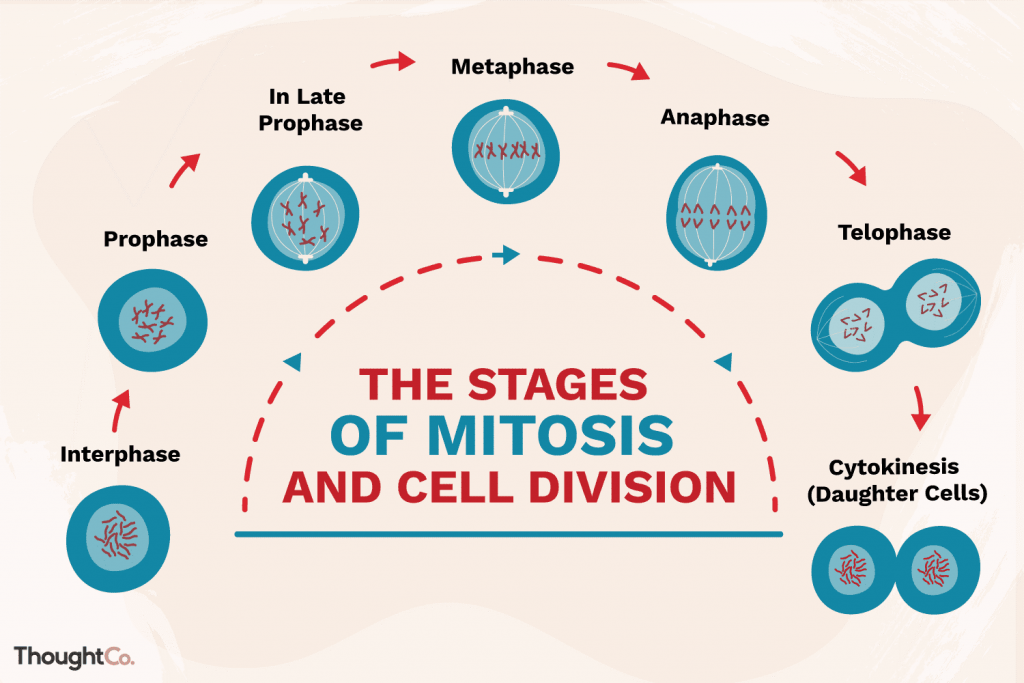Cell division means the reproduction of a single cell into two equal and identical daughter cells when divided. Those two daughter cells further divide into four cells and the process goes on and on. Cell division occurs in unicellular as well as multi cellular organisms and is of two types: Mitosis and Meiosis cell division. Details on the different stages of Mitosis cell divine will be discussed in this article.

- Eukaryotic cells during division passes go through a series of stages: Two gap phases (G1 and G2 phases), Synthetic (S) phase and Mitosis (M) phase. These series of stages is known as a cell cycle.
- Tissues when they undergo starvation or under generation, they reach at a targeted size where they exit out of the cell cycle and remain in stasis which is a G0 phase.
- But most of the cells re-enter the cell cycle where G1 phase takes place.
- In G1 phase, the cell starts making proteins and organelles for DNA synthesis and especially centromeres are prepared for the cell division to take place.
- S phase is the second growth phase where the DNA synthesis replicates the genetic material and each chromosome consists of two sister chromatids. Other organelles necessary for cell division are also synthesized in this phase.
- In G2 phase, metabolic changes that occurred in the S phase are assembled and for further mitosis and cytokinesis, the cytoplasmic materials are made. G1, S and G2 phase period is also known as interphase.
- M phase is the mitosis division phase followed by cytokinesis.
Mitosis cell division

- Mitosis is the division of one single cell into two identical cells by a process of cell duplication and distribution of chromosomes.
- During cell division, each daughter cell receives two genetically identical copies from one of the parent cells.
- Mitosis cell division occurs in unicellular and multi-cellular eukaryotes and the process is usually shorter than meiosis cell division. The process might take from 20 minutes to 10 hours varying on the organisms.
- The major purpose of mitosis cell division is for the growth and replacement of worn-out cells, wound healing, and tumor formation.
- Lack of replacement and mistakes during mitosis results in alteration of DNA molecules. It causes uncontrolled mitosis leading to genetic disorders like cancer, tumor suppressors, and oncogenes.
Mitosis is a continuous process and involves five phases:
- Interphase
- Prophase
- Metaphase
- Anaphase
- Telophase

Karyokinesis and Cytokinesis occur during the M phase of the cell division where the nucleus divides in the Karyokinesis and the cytoplasm divides in the cytokinesis.

Interphase
- Interphase is a period of growth of cells before entering into mitosis. This phase includes the G1 phase, S phase, and G2 phase which are already mentioned above.
Prophase
- Prophase and interphase is the first step in the mitotic process and occupies over half of the process.
- The chromosomes condense into X shaped structure, each composed of two sister chromatids joined at a centromere.
- At the end of the prophase, the nucleus membrane starts to dissolve and releases the chromosomes where the mitotic spindle (composed of microtubules and proteins) extends. And it moves to the opposite pole of the cell while the chromosomes migrate toward the cell center.
Metaphase
- A pair of homologous chromosomes migrate to the equatorial plane at the region of the mitotic spindle which is known as the metaphase plate.
- The mitotic spindle fiber binds to each of the sister chromatids which is called a kinetochore from both sides of their centromere.
- Chromosomes continue to condense and align at the metaphase plate making a right angle to the spindle poles.
Anaphase
- Anaphase is the shortest stage of the mitosis cell division process where the centromeres divide. And the paired chromosome (sister chromatids) separates by the mitotic spindle which pulls one chromatid to one pole and the other to the opposite pole.
- The separated sisters are called daughter chromosomes.
Telophase
- Telophase is the final stage where the polar fibers continue to elongate and nuclei begin to form at opposite poles.
- A membrane also forms around each set of chromosomes where two new nuclei are formed.
- The cell in between then pinches in the middle and forms two separate daughter cells.
- Each daughter cell contains a full set of chromosomes within a nucleus. This process is called cytokinesis.

Cytokinesis occurs by the division of a cell’s cytoplasm which occurs at the end of the anaphase and completes shortly after telophase. Two genetically identical daughter cells are produced at the end of the cytokinesis.
In animals, cytokinesis occurs by the constriction of the cytoplasm. While in plants, a cell plate forms along the line of the metaphase and final cellular division occurs and forms two new cells.
References:
- https://www.albert.io/blog/g1-g2-phases-cell-cycle/
- https://www.thoughtco.com/stages-of-mitosis-373534
- https://www2.le.ac.uk/projects/vgec/highereducation/topics/cellcycle-mitosis-meiosis
- https://www.yourgenome.org/facts/what-is-mitosis